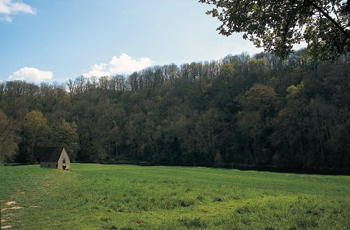Sarthe guide

France Today takes a tour around this department

They say variety is the spice of life, and if so, life in the Sarthe département of the Pays de la Loire can claim to be among the most piquant in all France. Each of the five areas into which it is split, for historical and administrative reasons, boasts splendid diversity of geography, architectural heritage and family-friendly tourist attractions.
Perhaps the best way to uncover the contrasting attributes of these five regions is to begin at the far south of Sarthe, in the pretty plains of the Vallée du Loire, before heading to the Vallée de la Sarthe, then into the ancient capital of Le Mans and the surrounding pays Manceau then exploring the beautiful, if differing, countrysides of the forested Maine Normand to the far north and the copse-strewn green fields of Perche Sarthois in the northeast.
Sitting at the foot of the département, an exploration of the Loire Valley alone requires a full week. Any fleeting visit to southern Sarthe should at least, however, include a quick look at the imposing, stunningly postitioned Château at Le Lude and the flower-decked ‘town in bloom’ of La Flèche, also home to a superb modern zoo.
Head northwards from here and you will soon get an inkling of the region’s multi-faceted identity. La Vallée de la Sarthe is famous for its tourisme fluviale (river tourisme). This comes as little surprise, as the best way of seeing the valley is by hiring a boat and taking a slow ride along its 100 or so miles of lock-dotted waterways. From the pleasure port in the heart of Sablé-sur-Sarthe, home of the famous butter biscuit sablé, boats can be hired for the scenic meander to Le Mans.
Away from the water, there are plenty of excellent historical monuments to visit. One of the best is the 12th-century Eglise Saint-Hilaire in the improbably cute village of Asnières-sur-Vègre. It has an array of remarkably well-preserved biblical frescos that date back to the 16th century and well beyond. For an equally impressive treat, head to the Abbaye Saint-Pierre in Solesmes. In this behemoth of a building, the resident monks emerge at four o’clock every afternoon to sing soporific Gregorian chants for tourists and churchgoers. A final stopoff before reaching Le Mans should be the beautifully conceived Espace Faïence in Malicorne. Not only does it pay homage to the town’s ceramic and earthenware heritage, which dates from 1750, but it also provides the chance to stock up on unique presents.
And so to Le Mans, best known as the site of an annual invasion of speed- and booze-seeking racing car fanatics for the 24-hour race, but otherwise cruelly overlooked as a tourist destination. It has plenty to offer the lower-octane explorer. Who could not be impressed with the giant Cathédrale Saint-Julien, a 135-metre long affair that took five centuries to build, for instance? Or the remains of the Roman wall that encircles the Old Town? Or the Old Town (Vieux Mans) itself, a maze of quirky backstreets lined with timber-framed houses and ornately decorated façades that represents a literal step back in time?
The town’s Fine Arts Museum (Tessé), with its range of Flemish and Dutch paintings, permanent egyptology exhibition and awesome collection of ancient firearms, is another must-see, while the main draw for die-hard car fans, apart from the famous race, is the fabulous collection of cars – old and new, sporty and otherwise – on show at the Sarthe Car Museum near the race circuit out of town.
Of all the wonderful food served up in Sarthe, which includes excellent pork, duck and chicken dishes, perhaps the best known regional product is rillettes, synonymous with Le Mans. A pâté-like pork starter served on hunks of crusty bread, it is rich, delicious and fatty, and best worked off with some exercise in one of the many outdoor pursuits centres in Maine Normand to the north of Le Mans. Mountain bikers are particularly well catered for here, too!
Characterised by peaceful woodland and extraordinarily long, straight roads linking one village to the next, Maine Normand is the place to get some fresh air and explore the backwoods. A popular spot for locals is Coco Plage near the charming town of Sillé-le-Guillaume. This huge man-made lake set in the forest here is the perfect place to try outdoor activities, on and off the water. Less strenous is a visit to Fresnay-sur-Sarthe, a fortified town with a 12th-century church whose sculpted door dates from 1528, while a drive up into the hills of Les Alpes Mancelles leads to one of the prettiest places in France. The hilltop village of Saint-Céneri-le Gérei is actually in Lower Normandy but no trip to Sarthe is complete without a look at its small chapel, which sits in a field backed by a huge wooded hillside. It is a stunning sight.
South of Maine Normand is the equally beautiful Perche Sarthois area. Essential viewing in this area patchworked with fields and hedgerows is the bizarre-looking 11th-century church-cum-château in Saint-Georges-du-Rosay. Complete with terracotta statues inside, it is a typical example of the area’s rich architectural appeal. Two more worthwhile detours are the pottery museum, the Maison du Potier, in the tiny village of Prévelles, and the town of La Ferté-Bernard on the River Huisne. Nicknamed the ‘Little Venice of the West’, its medieval architecture is best taken in during a gentle boat trip that starts near the tourist office.
Kids are well looked after in these parts. For great day out, go to the Domaine de Pesheray, an animal park and mini golf course set in the grounds of a 16th-century château and staffed by local handicapped people.
And so the whirlwind tour of Sarthe ends and its appeal is clear. It has something for everyone: fantastic architecture, excellent museums, diverse landscapes, rivers aplenty as well as lots of family fun, activities, fresh air and wonderful food. Comprised of five diverse regions, Sarthe is so much more than the sum of its parts.
GETTING THERE
AIR
Ryanair flies to Tours from London Stansted. From Tours, take the N138 to Le Mans.
SEA
Brittany Ferries sails from Portsmouth to Caen and Saint-Malo.
ROAD
Le Mans is the gateway to the Loire Valley and has excellent road access. To get there from Caen, take the N158/138 for Le Mans, and from Saint-Malo head for Rennes on the N137, then take the N157.
RAIL
Le Mans is served by TGVs from Paris. For details of these and other local train servies, contact Rail Europe.
OUTINGS
To hire a boat for a cruise along the Sarthe from Sablé-sur-Sarthe, contact Anjou Navigation in the port.
Visit the Faïence Museum in Malicorne, where visitors can trace the history of cermamics and buy gifts.
Entrance to the superb Musée de l’Automobile in Le Mans, which displays cars and motorbikes from every era of motor sport, is under 10 euros.
Share to: Facebook Twitter LinkedIn Email
Leave a reply
Your email address will not be published. Required fields are marked *



